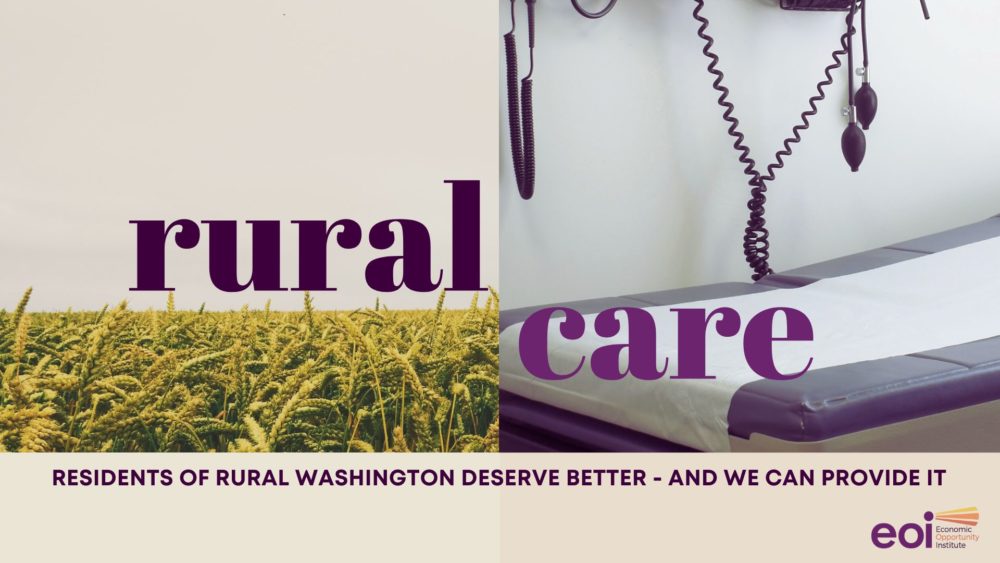
I’ve been in Seattle for over 20 years now, but I’m still a country girl at heart. There are so many reasons that living in a rural area can be a dreamy existence. I have fond memories of small-town life. I remember how quiet and cozy it felt to wake up in the tiny town of Davenport, Washington where I spent every weekend with my great grandparents as a young girl. We always ate at the same tiny diner and got mints for 5 cents at the corner store. And I loved being surrounded by the peace and natural beauty of my dad’s farm in a small town outside Spokane. It was heartwarming to see how our neighbors took care of one another, day after day and year after year.
But not everything about living the rural life is so idyllic. Rural communities have far less concentrated wealth as compared to urban areas, lower graduation rates, and fewer employment opportunities. Quality affordable housing, accessible transit, reliable internet, and food access can all be major barriers to economic security for rural people.
Rural Health Care: An Overlooked Challenge
Health care – something we all need to survive and thrive – is perhaps one of the biggest challenges of them all. While people all across our state struggle to afford health care, we know that those in rural areas often face unique challenges when it’s time to go to the doctor.
- In a recent survey taken in Washington, half of rural residents reported incurring medical debt, depleting their savings, or sacrificing basic needs due to medical bills.
- 85% of rural residents are worried about the cost of healthcare.
- 41% of rural residents are worried about losing health insurance – nearly twice the rate of non-rural residents.
- 65% of rural residents reported going without care due to cost in the last year.
We’ve seen some disturbing trends as our health care system becomes and more and more monopolized. Just a few decades ago, small local hospitals were pillars of our communities. But in recent years, large health care companies have bought up these local hospitals. They’ve created monopolies that take over entire communities and regions, only to then raise the price of care.
Prices should decline after a merger. But in reality, as big health care corporations, hospitals, and drug companies control more of our health care system, they charge more and more without improving care. This is especially true when it comes to rural health care. Research has widely shown that the unequal market power held by large hospital systems is driving up prices – sometimes by up to 30% following a consolidation.
We’re being priced out of health care.
Hospital prices increased 60% more than our paychecks over the last 25 years. OIC analysis of APCD data last year showed health care costs are rising at double the rate of ordinary inflation. National data shows that Washington has some of the highest average hospital prices in the country.
This is especially true in rural areas where people are already grappling with problems of proximity and cost. Wall Street speculator firms are buying our hospitals and then shutting down units that aren’t making their investors enough money. Units like maternity wards in rural hospitals – or entire rural hospital facilities.
The people of our state deserve better.
That’s why advocates from all across the state joined together recently at the State of Reform Conference in Spokane to discuss rural health care challenges. I spoke on a panel along with other advocates and helped convene a conversation aimed at advancing solutions to improve affordability and access for our rural communities.
We know urgent solutions are needed to solve this crisis – and advocates are working on many creative solutions: prioritizing workforce development, improving rural internet access, expanding telehealth options, supporting mid-level providers like dental therapists, and implementing the new Making Care Primary model that the Centers for Medicare and Medicaid launched in eight states (including WA!) this summer to help improve access to primary care
EOI is continuing our upstream effort to tackle the high cost of care with the Fair Health Prices – Washington campaign, which we launched with other consumer advocates, labor unions, and business leaders two years ago. We worked together with our partners this past session to advance solutions to improve accountability and make sure hospitals and drug companies aren’t allowed to charge whatever they want for lifesaving medications and services.
We’re hard at work now, already gearing up for a busy legislative session starting in January. This movement to make health care affordable for everyone – regardless of where we live – needs us all!
Do you want to join the effort to support affordable health care? Contact me at Sam@opportunityinstitute.org.
More To Read
February 11, 2025
The rising cost of health care is unsustainable and out of control
We have solutions that put people over profits
January 29, 2025
Who is left out of the Paid Family and Medical Leave Act?
Strengthening job protections gives all workers time they need to care for themselves and their families
November 1, 2024
Accessible, affordable health care must be protected
Washington’s elected leaders can further expand essential health care

Stan Sorscher
Another factor is consolidation of farming and agriculture and the associated decline in family farms. As corporate farming grows, population drops, putting pressure on local businesses, schools, and health care. This is the Wal-Mart effect on a larger scale. Rural economies are being restructured to the advantage of investors and disadvantage of communities.
Oct 15 2023 at 3:28 PM